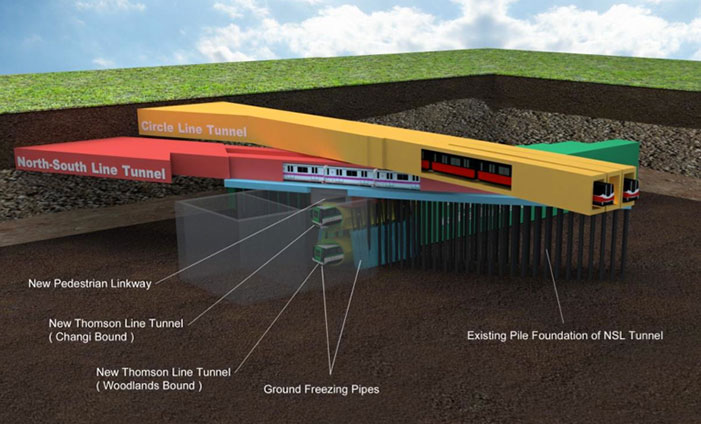Ground freezing first for Singapore rail project
2 July 2014
Peter Kenyon, TunnelTalk
- Ground freezing is to be used for the first time during construction of a rail tunnel in Singapore.
- Poor ground conditions at Marina Bay Station - where the country’s new 30km all-underground Thomson Line will run directly underneath the existing North-South and Circle Lines in a double deck configuration – necessitate use of the technology while foundation piles supporting a section of the upper-level lines are removed (Fig 1).
-

Fig 1. Ground freezing at Marina Bay Station
- After construction of a pedestrian linkway beneath the North-South Line (NSL), up to 20 of the foundation piles that currently support both of the lines above at their intersection point will need to be removed. This will facilitate construction of the deep-level Thomson Line station boxes, which will be constructed one above the other. In total a 40m stretch is affected by the need to remove existing piles and provide ground freezing support. The work will be completed under Contract T226, which was awarded to the Tasei Corporation of Japan in February this year for a contract sum of Sing$425 million.
- "One of the key challenges of the whole project is in constructing the pedestrian linkway and the tunnels, which run directly below the North-South and Circle Lines' existing tunnels, and coupled with the poor soil condition in the area this makes the construction of the Marina Bay Station very complex and very challenging,” said Shaik Sha Marican, Singapore Land Transport Authority Director of Civil Team 4 for the Thomson Line.
- "To alleviate the problem posed by the soil conditions, what we're going to do is ground-freezing, freezing the ground water into ice to form an ice wall that will solidify the ground and facilitate the construction of the tunnel."
- Thomson Line construction work will also necessitate excavations under other existing rail stations, requiring innovative engineering solutions. Orchard Station, for example, is located in a densely built-up area with high pedestrian traffic. Contractors will be required to complete mining works under the NSL station’s multiple-level platforms, taking into consideration the existing foundation piles, all with minimum disruption to ongoing rail and retail operations. Adding to the complicated site conditions, the interfacing works with the NSL station can only be carried out within a very tight schedule, after the line’s passenger service hours each day.
-

North-South alignment of the 30km Thomson Line
- On June 27 (2014) a groundbreaking ceremony in the presence of the country’s Minister for Transport, Lui Tuk Yuw, was held to celebrate the start of underground construction of the Thomson Line, the country’s sixth MRT line, which will connect the northern part of Singapore to the Central Business District and Marina Bay areas and add capacity to the north-south corridor. It is major step towards project owner Singapore LTA’s vision of doubling the length of Singapore’s rail network by 2030.
- “The Thomson Line is part of the Government’s efforts to improve the capacity and service levels of our rail network as quickly as we can,” said Lui Tuk Yuw at the ceremony, held at the Woodlands Station construction site. “Over the next three years, Singaporeans will continue to see new lines and extensions opening, as we continue at an unprecedented pace of rail building.”
- The Thomson Line is expected to open in phases, beginning in 2019. By 2021, the line will comprise 22 stations, including interchanges with all of the country’s other MRT lines at six stations: Woodlands, Caldecott, Stevens, Orchard, Outram Park and Marina Bay. Of the 24 civil contracts, 21 have been awarded to a total value of Sing$6.7 billion.
- With connections to the North-South Line, the East-West Line (NSEWL), the North East Line (NEL), the Circle Line (CCL) and the Downtown Line (DTL), the Thomson Line will link communities in Woodlands, Sin Ming, Thomson and Kim Seng to the CBD and the rest of the island. When the line fully opens, it is projected to see a daily ridership of around 400,000 commuters.
- In the long term, discussions are still ongoing between authorities in Singapore and Malaysia regarding a possible tunnel crossing of the Johor Strait between Woodlands North Station, at the northern end of the Thomson Line, and Johor Bahru on the Malaysian mainland. A consortium of AECOM Singapore, AECOM Perunding and SA Architects of Singapore holds a US$42 million contract from Malaysia's Land Public Transport Commission (SPAD) and Singapore's Land Transport Authority to carry out an engineering study of the proposed Malaysia-Singapore Rapid Transit System (RTS) link.
-
Singapore rolls out Thomson Line packages – TunnelTalk, April 2014
Tunnel option for Malaysia-Singapore link – TunnelTalk, May 2012
Singapore and Malaysia hungry for TBMs – TunnelTalk, July 2013
|
|
|
|
|
Add your comment
- Thank you for taking the time to share your thoughts and comments. You share in the wider tunnelling community, so please keep your comments smart and civil. Don't attack other readers personally, and keep your language professional.
